Spotted
Elk/Big Foot: I don't think that Spotted Elk
was a biological son of Lone
Horn. Census records indicate his birth about
1826, when Lone Horn was 11 or 12. It is worth noting
that several Lakota accounts -- admittedly vague -- indicate
that Big Foot and Lone Horn were not father and son, but
brothers. Frustratingly, I have not been able to clear
up this problem with family descendants. One interpretation
that I think is worthy of consideration is that one story
about Big Foot identifies him as a nine-year old orphan
on an Oglala war-party against the Pawnees, a raid dated
by the 1833 Leonid shower When the Stars Fell. There are
circumstantial details in the story that match up with
a raid recorded in the fall of 1835. Since the elder One
Horn was killed by a buffalo bull in July 1835 at Bear
Butte, could Spotted Elk have been his orphaned 'son'
subsequently raised by the younger Lone Horn? On bands,
one of my consultants named Spotted Elk's band as the
Hehepiya, meaning something like At the Foot
of the Hills. This may be a reference to Big Foot's camp
location on the Cheyenne River in the 1880s. Josephine
Waggoner's brief profile names Big Foot's band as the
Inyan ha oin (Musselshell Earrings), but this
seems unlikely - at least in any sense of permanent residence.
— Kingsley Bray
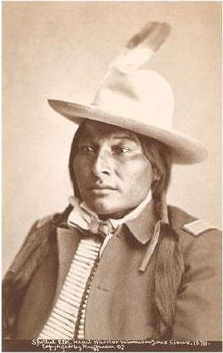
This
photo by L A. Huffman
is the one being discussed.
If
Big Foot was that old, then surely the Huffman photos
that are often claimed to be him, must be of another man?
— Grahame Wood
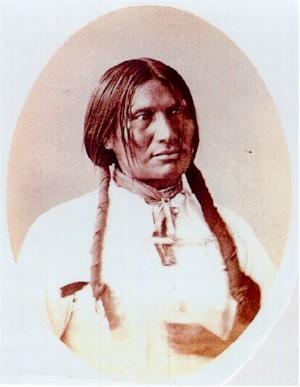
Photo
by Alexander Gardner, 1872.
This is actually Big Foot the Oglala rather than the Miniconjou.
I
was thinking and wondering about all the different published
Big Foot photographs for a long time.
The
Huffman photo is labeled Spotted Elk. He looks very young,
also maybe too young.
To
me the most reliable picture of the Big Foot who was killed
at Wounded Knee is in the group photo of the Cheyenne River
delegation at Washington in 1888 by Thomas Smillie.
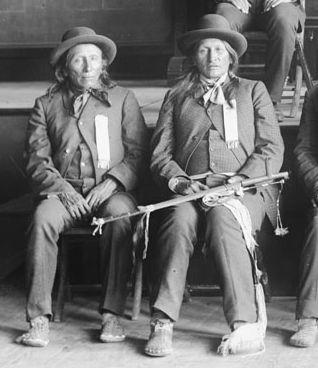
Spotted
Eagle (Sans Arc) & Big Foot (Miniconjou)
The
second Big Foot photograph was made by Alexander Gardner
in 1872. Although it has been published hundreds of times
as the chief killed at Wounded Knee, I really doubt this.
Gardner pictured delegates from several Sioux tribes (Oglalas,
Brules, Yanktonais), but no Miniconjous. The Big Foot photo
was attached to the Oglala delegation, led by Red
Cloud. There are other hints. If you take a
look at the 1868 treaties, there was indeed an Oglala chief
named Big Foot. Catherine Price states in her book that
the Oglala chief Big Foot was among the delegates who went
to visit the President in 1872.
In
1875 there went another delegation to Washington. This time
Miniconjou chief Lone Horn went along. In the group photograph
of 1875 there is also a Big Foot shown. This must be the
son/adopted son of Lone Horn (Also pictured in the photo
is White Swan
III). — Dietmar Schulte-Möhring

The
photos above are cases of mistaken identity. The first was
taken by Huffman. This Spotted Elk was one of the Miniconjous
to return from Canadian exile and surrender at Ft Keogh.
That means he isn't Spotted Elk/Big Foot, who surrendered
at Cheyenne River Agency in February 1877 and remained there
until the tragic last days of his life. As a possible solution
to his real identity, there is a Miniconjou listed in the
Spotted Tail Agency census of 1877, a single man living
in Roman Nose's
lodge - probably one of his 'sons'. He probably fled to
Canada with the Roman Nose outfit in January 1878. So the
Huffman photo could be him after his return from Canada.
We definitely need Ephriam in on this one. Does Spotted
Elk show up in the Miniconjou roll taken at Standing Rock
in 1882 and listed in Hump's camp; i.e., the Miniconjous
from Ft. Keogh?
This
Huffman image strongly resembles the Spotted Elk who accompanied
the Pine Ridge delegation to Washington in 1891 in the aftermath
of the Wounded Knee tragedy. In 1931 anthropologist Scudder
Mekeel obtained a list of contemporary Oglala communities.
One of the White Clay District communities he listed as
Spotted Elk or Opangalicka (also called Big Belly
of Spotted Elk Band). Spotted Elk's other name is Big Foot.
The one who was massacred at Wounded Knee. This man was
the present Spotted Elk's father's brother." So, connections
still provisional, but this "present Spotted Elk"
could be the same man photographed by Huffman, a nephew
of Big Foot's (in our system; in the Lakota system he would
have been a son), possibly the son of Roman Nose. This would
also tie up both Roman Nose and Big Foot to the Big Belly
band of Miniconjous. But we are at the outer edge of conjecture
here.
The
other shot of Big Foot was taken by Alexander Gardner in
1872, one of his portraits of the Oglala delegation to Washington
that spring. Despite numerous reproductions as the famous
Big Foot, this is not the Miniconjou of that name. A Big
Foot consistently appears in Oglala censuses and band tallies
across the period 1871 to 1882, his band affiliation shifting
between the Kiyaksa and Loafer bands. His first
recorded appearance seems to be in Sept. 1868, when his
camp of 18 lodges - then identified as Lower Brules - accompanied
Spotted Tail's
removal from the Republican River hunting grounds to the
new Whetstone Agency. John G. Bourke's extraordinary diary
account of the 1882 Pine Ridge Sun Dance names Big Foot
as one of the presiding holy men. —
Kingsley Bray

Here
is some information regarding the 1888 delegation group
photograph by Smillie.
According
to Herman J. Viola's book Diplomats in Buckskin,
the delegation photos were sent by the Smithsonian Institute
to the Indian agents at the agencies so that the pictures
could be properly captioned. The Cheyenne River agent said
about the chiefs in the photo posted by myself and Grahame:
No.
1 - Spotted Eagle is a Sans Arc Sioux, 54 years old - he
surrendered in 1881, with Sitting Bull - since the surrender
he has been quiet and peacable.
No.
2 - Spotted Elk is a Minniconjou Sioux, 59 years old, he
came in from the hostile camp in 1876 has made but little
progress.
If
this is right, this Spotted Elk would have been born in
1829. — Dietmar Schulte-Möhring

I've
also seen this photo labelled as Big Foot and he doesn't
seem to be the same man as above:
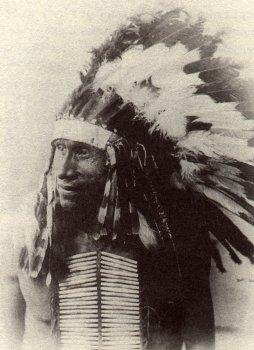
—
Grahame Wood
Big
Foot was raised as a 'son' by Lone Horn II (circa 1814-76).
New information (in the Clown family's DVD on Crazy
Horse, but backed up by other documents just
coming to light) states that Big Foot's biological father
was One Horn I (ca. 1787-1835), the chief
painted by Catlin and killed by a buffalo bull.
Big
Foot was born 1826. — Kingsley
Bray

I
found this photo of Big Foot in Donovin Sprague's book Cheyenne
River Sioux.

In
another book of Sprague he make some interesting genealogical
statements about Four Horses, the daughter
of Lone Horn, and Kate Hunter, also known
as Kills Plenty, her daughter:
Four
Horses was the daughter of Lone Horn and Wind,
one of seven wives of the old chief.
Black Buffalo was the father of Lone Horn
and High Backbone
(Hump).
Big Foot (Si Tanka) is related to Wind, Stiff
Leg (another wife of Lone Horn) and the One/Lone
Horns. Further:
Wind
was killed at Wounded Knee at age 78 in 1890 with grandson
Big Foot, however she would have been about 14 years older
than him. In Lakota kinship, Wind may have called him
a son, due to him being a son of One Horn and one of his
wives. Some tie Si Tanka to Wind, or to her sister
Stiff Leg.
— Dietmar Schulte-Möhring

Here is an edit of the group photograph of the 1875 Sioux
delegation.
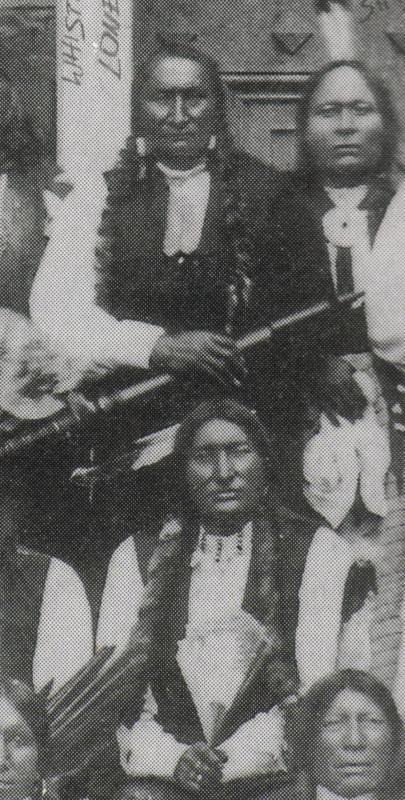
Lone Horn (above) & Big Foot (below)
To
me this Big Foot bears a resemblance to the man in the Smillie
photo of 1888. — Dietmar Schulte-Möhring
Back
to the Top